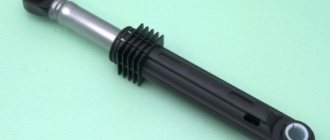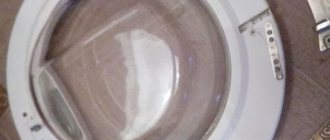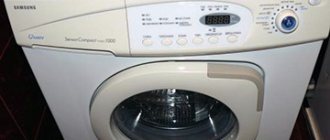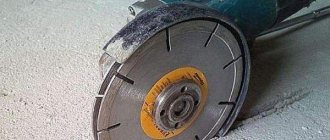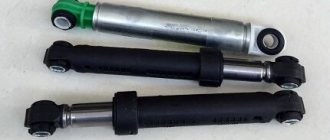A heating element, or tubular electric heater, is necessary to maintain the temperature during washing.
In LG washing machines, this part is one of the most vulnerable. The heater often fails due to long service life and violation of operating conditions.
What it looks like, where the heating element is located in an LG washing machine, how to get it out and replace it, if necessary, we will tell you further.
What does it look like and work like?
The heating element of an automatic washing machine (WMA) is a curved smooth tube with a conductive wire running inside it. The internal part is made of alloys with high electrical resistance. Changing the current parameters allows you to adjust the heating intensity .
Between the body and the working element there is a layer of material with high thermal conductivity. Between the contacts of the heater there is a socket for a temperature sensor, which determines the water temperature.
Some LG car models are equipped with heating elements that do not have an additional hole. In this case, the temperature sensor is located directly inside the tank.
To fix the heater more tightly in the seat, it may have a sealing collar or collar . This must be taken into account when choosing a part. Instead of a heater without a thermostat, you can install a heating element with space for a sensor, but the hole will require a special plug.
How to change an Indesit top-loading washing machine?
For Indesit washing machines with vertical loading, the heating element is replaced through the front or side panel of the case.
Algorithm of actions:
- The machine is disconnected from the power supply, water supply and sewerage.
- The fixing bolts are unscrewed and the side panel is removed.
- There is a heating element located in the lower part of the housing under the tank; all wires are disconnected from it.
- The central nut is loosened with a socket wrench, the bolt is pressed in, and the heating element is pulled out.
- The new element is inserted into a seat cleared of debris and scale.
- The heating element is connected to the wiring.
- The side panel is returned to its original place and secured with bolts.
After repair, the washing machine is connected to communications, and a test wash is started.
Causes and signs of part failure
Depending on the quality of the part and operating conditions, the service life of the heating element ranges from 2 to 10 years.
The reasons for its failure are:
- manufacturing defects;
- the formation of a thick layer of scale, which impedes heat removal;
- incorrect choice of heater or temperature sensor when replacing;
- damage to the metal body of the part;
- a sharp surge in voltage in the network, which leads to burnout of the conductive wire.
If the heating element is working, but does not heat the water, then the problem may be a breakdown of the temperature sensor, protective relay or electronic control unit of the machine. To protect the heating element and the electronic unit, the SMA is connected to a voltage stabilizer or relay, which disconnects the device from the network if the nominal parameters are sharply exceeded.
The main signs of a malfunction are the lack of heating of the water or the washing temperature is too low for the set program. If the heater body is damaged, a short circuit may occur, which leads to the machine switching off at the meter.
If the temperature mode does not correspond to the program, then LG washing machines with a display issue a code tE (from “temperature error”). SMAs without an electronic display indicate a problem by flashing or continuous lighting of all temperature indicators. As a rule, the tE error appears a few minutes after the wash starts.
When error tE appears, the machine stops working, so if you need to continue washing, you should select the cold water mode (if there are signs of damage to the heating element housing, it is prohibited to turn on the unit).
Prevention
Do not forget about preventive measures regarding the Indesit washing machine. Having replaced the old heating element with a new one, maintenance of the tank will be required in order to remove the dangerous deposits accumulated there. The tank may contain solid impurities in the form of scale. Sometimes undigested fats from things are deposited there (in the form of mucus). This fat gives off an unpleasant odor.
Preventive measures should be carried out periodically, depending on how often you run the wash and at what temperature conditions. So, to prevent the formation of deposits in Indesit machines, it is recommended to do the following.
- A special salt filter will need to be installed in the operating water supply gap. This must be a high-quality softener, which will always need to be replaced in a timely manner.
- For washing, it is recommended to use only high-quality powders and gel compositions - with their use, heating elements and other components of washing machines last much longer.
- Do not forget to carry out periodic preventative maintenance on your appliances against scale by using specialized products sold in many retail outlets. People often use folk remedies, such as vinegar or citric acid, which easily remove excess fat deposits and scale. But we must take into account that no one can say for sure how these chemical compositions can affect the condition of the rubber elements and seals of the machine.
- Do not overdo it with too frequent wash cycles using high temperature water. Detergents produced by modern manufacturers can effectively combat most contaminants at low temperatures. Thus, washing clothes is more gentle and gentle.
- You should always keep the condition of your household appliances under control. Of course, many users do not delve into possible problems and think about them only when they encounter them. It is advisable to check from time to time whether all components of the unit are working properly and whether there are any malfunctions.
See below for a master class on replacing the heating element.
How to remove and replace?
For diagnostics and repairs, you will need a Phillips and flathead screwdriver, a wrench ("8"), lubricant (for example, WD-40) and a multimeter. If there are signs of heating element failure, you must:
- Disconnect the SMA from the network, wait 15-20 minutes. After this, turn on the unit and start the program again. If the sunroof glass remains cold for several minutes or the tE error occurs again, drain the remaining water in the tank and proceed with diagnostics.
- After turning off the machine, slide and remove the top cover. Close the inlet hose. Disconnect the drain and inlet hoses.
- Remove the screws that secure the back panel. Dismantle the wall.
At the bottom of the tank, find the external contacts of the heating element. If the part is covered by the drive belt, remove it from the disk.- Check the fit of the wires to the terminals.
If one of them comes off, secure it in place and check the operation of the machine. When all the wires are tightly fastened, take a photograph of the order in which they are connected and begin dismantling. - Loosen the central nut that secures the heater. Remove the temperature sensor. Press down on the nut and stud.
- Grab the heating element body and pull it out of the groove, swinging it slightly. During the removal process, do not touch the contacts. If during operation the sealing ring has hardened and makes it difficult to remove the heater, you need to carefully pry it off with a flat screwdriver.
- Inspect the surface of the heating element for damage and scale. If the part is covered with a thick layer of sediment, immerse it in a warm solution of a weak acid (citric or acetic acid).
- Switch the multimeter to resistance measurement mode, connect the probes to the heater contacts. The permissible value is 24-40 Ohms, depending on the heating element model (to calculate the resistance, use the formula R = U2/N, where U is the network voltage, and N is the rated power). If the display shows a lower value (less than 10-15 ohms), the part is faulty.
- After checking, clean the seat from scale and other contaminants. Apply grease to the groove and rubber seal.
- Insert a new part, after checking it with a multimeter. Reinstall the temperature sensor, tighten the fasteners and connect the wiring.
- Install the back panel, connect the hoses and start washing without laundry at 60-900C. Check the water temperature (for example, by touching the hatch).
If the heating element is working properly, then you need to remove the temperature sensor, measure its resistance at room temperature and after immersing the working part in hot water (in the second case, the readings should be significantly lower).
Video instructions for replacing the heating element:
Where is the heating element located?
Before you begin work on replacing the heating element, the water is drained from the machine. It is de-energized and only then disconnected from the water supply and sewerage system.
The equipment is deployed so that access to the rear of the machine is ensured, after which the panel is carefully removed.
First you need to determine the location of the TEN. There is no drive belt in LG household appliances, so it will not interfere with the removal of the spiral, but it is better to clarify what structure the machine has before starting work. This information is given in the instructions.
When the back wall is removed, a view of the internal parts will open. The spiral is easy to find; its contacts will be clearly visible. It is located near the barrel. There are many wires connected to it, everything is carefully disconnected.
It is necessary to remember the location of the wires; it is better to draw a diagram.
This stage is important. If the wires are mixed up when connecting, the heater will fail, and the machine may also break down.
Where and at what price can I buy a new one?
You can buy a new part in an online store, an LG service center or from a supplier of spare parts for equipment in your city. The easiest way to select the right part is to show it to the seller or name the marking. You can also determine the standard element from catalogs for washing machine models.
When purchasing a heater online, you need to consider the following parameters:
- seat dimensions;
- presence of a collar, seals, holes for the sensor;
- configuration of the working part of the heating element (shape, length and width);
- power.
LG washing machines are equipped with heating elements with a power of 1.1 to 3.2 kW and a length of 173-240 mm.
If a strictly similar part is not supplied, you can select a heater with similar characteristics . The permissible discrepancy in length is -1 cm, and in power - ±200 W. The new element must have the same shape as the previous one: straight or curved.
Some models of heating elements have a protective coating, which does not affect its configuration and interchangeability, but increases wear resistance and service life. The cost of the heater ranges from 400 to 1500 rubles. The best manufacturers of tubular elements for LG washing machines are IRCA and Thermowatt.
What will be needed for replacement?
So, having purchased the necessary part for repairing washing equipment, prepare the tools for its installation. You will need:
- Two screwdrivers - flat and Phillips;
- Spray lubricant to loosen boiled joints (eg WD-40);
- Multimeter;
- Keys and socket heads of the required sizes to remove the back cover (in most cases, a “figure eight” will do).
How much do the services of a master cost, where can I find one?
The cost of repairing or replacing the heating element in the service ranges from 1800 rubles. excluding the price of a new spare part . If the problem lies in the temperature or drying sensors, then replacing them will cost about 1,700 rubles. In case of malfunctions of the electronic unit or the heater control system, the cost of repair starts from 2,600 rubles.
When contacting a private master, you can reduce costs by 10-25%. If the washing machine is under warranty, then you should only contact the official service center of the brand.
To select a service provider, you can turn to directory sites and trading platforms. To minimize the likelihood of fraud, you must:
- Find reviews of companies on city forums, and when reading, pay attention to the spread of response dates.
- Call the most popular and reliable services, compare the cost of diagnostics and replacement parts.
- Find out the legal addresses of companies and check the presence of a branch at the specified coordinates.
Before starting repairs, you need to discuss the estimate with the technician and follow the diagnostic procedure. Reliable home appliance repair companies provide a receipt, a certificate of completion and a guarantee for the services. Depending on the type of malfunction, the warranty period ranges from 6 months to 2 years.
Stopping the washing machine during a cycle
- Incorrect position of the program selector knob. You need to check whether the handle is set to pause in the rinse mode.
- There is no power supply. You need to use a tester to check the presence of supply voltage in the outlet. It may well be that the plugs on the power panel have burned out or the machine has turned off.
- Blockage. Clean the inlet and outlet hoses.
- The pump is clogged or broken. It is necessary to remove the pump and check the rotation of the impeller. If the need arises, change the pump.
- The inlet valve is faulty or clogged. You need to clean it and, if necessary, replace it with a new one.
- Siphoning through the outlet hose. At the same time, water fills into the machine and it cannot carry out the set program. You need to check the quality of the connection between the riser and the outlet hose.
- Thermal relay failure. Let's check its work.
- Damage to the heating element. It is necessary to ring the electrical circuit of the heating element.
- Timer fault. The timer is included in the programmer. It is located at the front of the machine and is controlled using a control knob or special buttons. The device is too difficult to repair; it is easier to install a new one.
- Electric motor failure. To quickly check it you need to:
- remove the drive belt;
- set the program switch to “spin” and close the outer panels;
- plug the plug into the socket and check if the motor rotates;
- if not, you will have to disassemble the electric motor and check it.
Description and principle of operation of the heating element
The heating element is an electric heater responsible for heating cold water supplied from the central water supply system to the washing machine.
Structurally, it consists of a W- or V-shaped tubular part, inside of which there is a conductor element with a high level of resistance that can withstand heating to record high operating temperatures.
A multimeter will help you carry out a correct check of the heating element. Using this measuring device, you can “ring” (test) the heating element at home and determine whether it is working or not.
The heating coil is surrounded by a special dielectric insulator with a high thermal conductivity. It correctly absorbs the heat emanating from the heating element and transfers it to the steel outer shell.
The working spiral itself is soldered with its outgoing ends to the contacts, which receive power during operation. Nearby there is a thermal unit that measures the level of water heating in the washing tank.
When activated through the control unit of any of the processing modes, a command signal is sent to the heating element.
The element begins to warm up intensively and, releasing the generated heat, brings the temperature of the water in the washing drum to the required temperature specified by the user.
Progressive models have a special hole in their design for a temperature sensor (in the figure the arrow points to it). It vigilantly monitors the level of water heating in the drum and promptly turns off the working element, allowing you to rationally and economically consume electrical energy
As soon as the water reaches the required temperature, the sensor records this and transfers the data to the control unit. The system reacts to the information received and automatically turns off the device, stopping water heating.
Removing the shade
Now you know how to remove the heater from the LG washing machine, all that remains is to loosen the central nut of the part and push the bolt holding the heater inside, after which you can start removing it. The sealing rubber bands are extremely reliable, so removing the part will not be so easy, the main thing is to do everything as carefully as possible, in order to avoid damage to the equipment itself. Once everything is ready, you can begin installing a new tena.
Similar articles:
- What do the icons on a washing machine mean: what symbols are on different brands of machines, photos
- Error codes for Asko washing machines (Asko) - how to fix them
- 7 best cordless lawn mowers - Rating 2020
- TOP 15 best glass-ceramic stoves: 2022 rating in price/quality ratio and choose
Replacing the heating element in a washing machine
We discussed why a heating element is needed in a washing machine, and why we cannot get rid of it yet. We have a regular boiler inside the device, which brings the temperature to the set temperature. To be fair, let’s say that there is not always a regular spiral, which is often shown in Calgon advertisements. There are also washing machines equipped with instantaneous water heaters. This allows you to complete the cycle much faster, but is accompanied by some technical difficulties in implementing the idea itself.
To be fair, let’s say that washing machines, unlike dishwashers, most often have heating elements. That is, tubular electric heaters that have nothing to do with induction, but are made in the form of traditional spirals of various shapes. However, there is one caveat:
The heating element of a washing machine for water is usually located at the bottom of the tank, somewhere under the drum (maybe a little on the side). At the same time, the heating element for air is usually located in the upper part of the housing in the area of the air duct. Any of them may require replacement. The typical price of a heating element for a water washing machine is about 1000 rubles. Of course, the cost of the issue largely depends on the brand of the device. It is also worth mentioning that in old washing machines there was an induction water heater that worked like a transformer, the secondary winding of which was a coil of aluminum wound (on an insulator) around a steel tube. Foucault's currents quickly heated the iron, and from it, the water.
And here are the first instructions! First of all, you need to look at what type of heating element the washing machine has. The easiest way to do this is to disassemble the case. In this case, the heating element is removed from the tank; there will probably be inscriptions on it that will tell you what kind of model it is. The second thing we do is check to see if there is any protection on the heating element. These are usually some kind of tubular structures that are not spiral and reinforced with steel clamps. There are at least three types of heating element protection:
- Bimetallic. This triggers the microswitch, which is located outside the heating element and is visible to the eye. The causes of the malfunction are usually the following: scale deposits or switching on with an empty tank. In any case, the carbon deposits are removed and the microswitch returns to its original state. There is some chance that the heating element of the washing machine is operational again.
- The solder protection releases, due to melting, a ceramic rod on a spring, which opens the relay inside the heating element housing. The device will have to be disassembled and the rod shortened. In the future, protection against overheating is no longer guaranteed.
- In the simplest case, there is a regular thermal fuse inside the tube attached to the heating element of the washing machine. It needs to be replaced.
The repair is quite simple. Don't forget to stock up on waterproof sealant, one that is not afraid of heat and will not cause allergic reactions. We have already raised this topic, but you can’t keep everything in your head. It is allowed to use Poxipol for the washing machine, which is NOT intended for food containers. During washing, a large amount of harmful substances will not be released. It's another matter if there is a turbo dryer. Here the dose of formaldehyde in the air is guaranteed, and it is better not to use Poxipol.
Please note that we have not yet told you how to change the TEN yourself. There is no such concept in nature. Also, do not try to buy a heating element for a washing machine in an online store.
Good luck!
Also, do not try to buy a heating element for your washing machine in an online store. Good luck!
If suddenly such a nuisance happened that your washing machine stopped heating the water, then most likely the heating element has failed.
You will learn how to replace the heating element of a washing machine yourself in this article.
How the malfunction manifests itself
If you notice that the water does not heat up during washing, you should not immediately disassemble the machine. You need to make sure that the spiral is not working, and then determine the reasons for this phenomenon.
First, you should understand that after rinsing is completed, the laundry should not be warm. To save electrical energy, cold water is used, so it is impossible to determine from the temperature of wet laundry whether the heating element is working or not.
The check is performed in a different way: 20 minutes after the start of washing, the palm is placed on the glass of the loading hatch. If it is warm, the heating element is working. A cold surface indicates that the water is not heating up. In this case, you will have to change the heating element.
Many owners of household appliances are interested in what causes the heater to fail. Failure occurs in the following cases:
- Failure of the heating element due to scale. The reason for its formation is hard water, which contains high concentrations of magnesium and potassium salts. When the heating element is turned on, the water heats up and substances settle on the surface of the spiral. After some time, the coating becomes harder, turns to stone, and the entire surface of the part becomes covered with a crust. This leads to a disruption in heat exchange, and the heating element burns out.
- The coil may burn out due to a voltage drop.
When the heater fails, it is replaced, but you need to start with preparatory measures.

